How to process white bloom on currant leaves: chemicals and folk remedies
In late spring - early summer, gardeners often find white bloom on currant leaves. What does it mean and how to treat the shrub so as not to harm the crop?
You cannot ignore the disease, because it can appear from year to year, affecting not only currants, but also neighboring plants. And processing alone is not enough. An integrated approach is important, including compliance with the rules of agricultural technology, preventive measures and the treatment itself.
The content of the article
What does white bloom on currant leaves mean?
A dense bloom (usually gray) on young leaves and currant shoots is the final stage of plant mycosis. At the initial stage, whitish spots and transparent drops can be seen.
This is a fungal disease - powdery mildew... Its development is provoked by several species of parasitic fungi of the genus Spheroteka. There are also names: berry death, white, ash.
For reference... The period of distribution of fungal spores falls on the end of April - beginning of May. In June, you can already see the first signs of damage on the leaves and ovaries of the currant.
There are no plant varieties that are completely resistant to the disease. Black currants require special attention. In the first year shrub planting the fungus can destroy more than 70-80% of the crop.
Some varieties have been developed that can resist the disease for a long time and are easy to treat. In other cases, the fight against powdery mildew must be complex, otherwise you can be left without a crop.
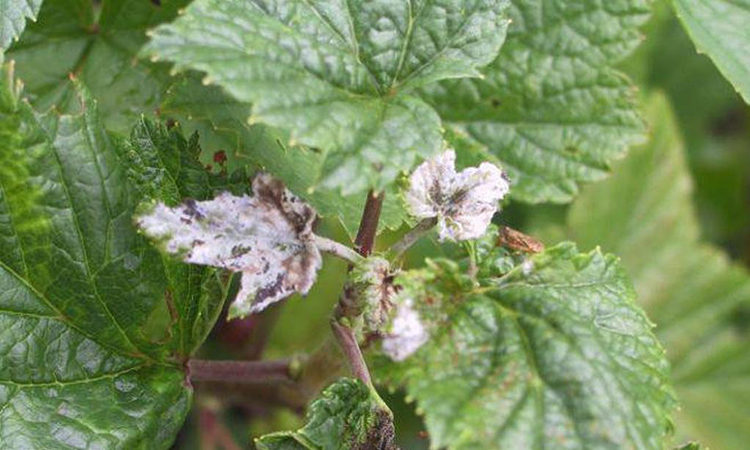
How to spray currants from powdery mildew
In most cases, the disease develops due to high temperature and humidity. Therefore, along with the processing of the plant, you need to adhere to some recommendations in order to neutralize the provoking factors:
- avoid spraying with water, drip irrigation is recommended;
- refuse stimulation with nitrogen;
- allow a little shade only on hot days.
How to treat white bloom on currant leaves? Better to combine chemicals and folk remedies. The latter, as an independent method, are ineffective. Their action ends after rain or strong wind. Chemicals are poisonous and hazardous to health, which precludes frequent use.
For reference. After the formation of the ovary, treatment with chemicals is prohibited.
Chemicals
For plant protection, biofungicides and fungicides are used. Fungicides are effective but toxic. Often, several treatments are enough per season. Biological preparations have a short duration of action, are water-soluble, which requires subsequent treatments at least once every 5-7 days. These funds are practically harmless to health.
Let's talk about the most common biofungicides.
"Fitosporin"
Suppresses the growth of mycelium (the body of the fungus). Can be applied at any time at any stage of plant development. But, as practice shows, the drug is effective only at the initial stage of fungal activity.
It is sold in the form of powder, aqueous suspension and paste. It is bred strictly according to the instructions. The accepted consumption rate: 5 g of powder per 10 liters of water. It is used exclusively in cloudy weather or in the evening.
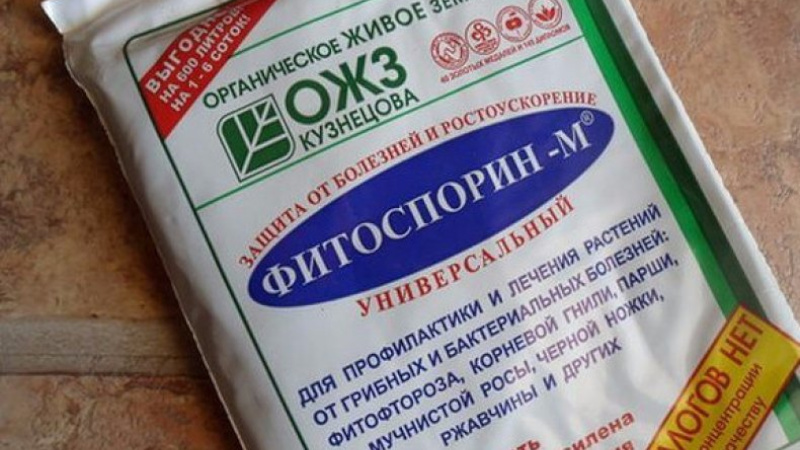
"Trichodermin"
A drug with a pronounced antifungal action based on bioactive substances released during spore germination.Stimulates plant growth, fertilizes soil. Does not affect the taste of berries, it is harmless to the body.
Available in powder and water suspension form. A mother liquor is prepared from the powder: with constant stirring, 1 package is diluted in 1 liter of warm water and left for 1-2 hours in a warm place.
"Trichophyte"
Analogue of "Fitosporin" and "Trichodermina". Non-toxic. In addition to destroying pathogens, it enriches the soil with small doses of nitrogen, potassium, phosphorus, iron, copper, sulfur. Shows high efficiency in the fight against plant mycosis.
It is produced in the form of a suspension. Treatments can only be carried out at night. Consumption rate for garden crops: 100 g per 10 liters of water.
Attention! When using the following group of drugs, care must be taken: work in a protective mask, clothing and gloves, carry out processing in dry and calm weather.
"Bordeaux liquid"
Contact action pesticide. It is a mixture of copper sulfate, lime and water. After application, it protects the plant for a month.
In case of partial infestation of shrubs, three procedures are recommended: before leafing out, at the beginning of the growing season and after flowering. When all plants are affected, the number of treatments is increased to six. The latter is carried out no later than 2-3 weeks before harvest.
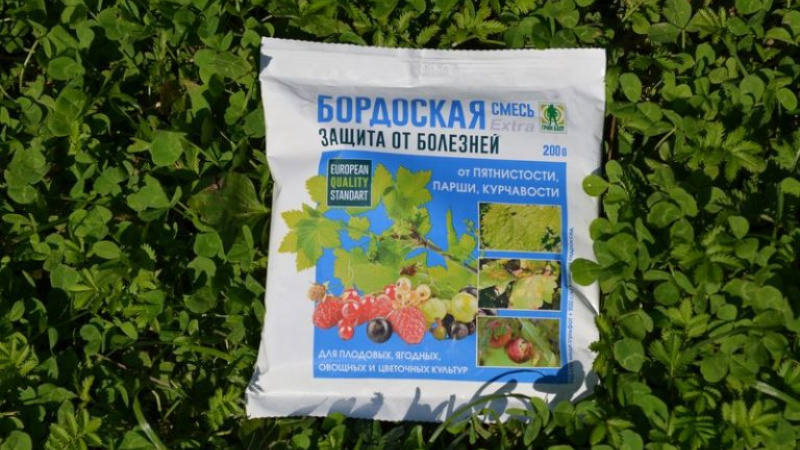
"Previkur"
A product with a pronounced fungicidal and biostimulating effect. It is used for spraying, drip irrigation, root irrigation. Consumption rate: for 1 liter of water 5 ml of the drug. Processing is carried out with inactive sun.
Important! When preparing the mixture, the pH of the water should be 5.5. In alkaline or strongly alkaline water, the agent loses its effectiveness.
"Topaz"
The systemic drug based on penconazole is available as a solution. Suppresses the growth of mycelium 3 hours after the initial application. Can be used in all weather conditions. Well compatible with other fungicides. Dosage: for 10 l of water 2 ml of the product. Pre-stir in 2 liters of water, then gradually add 8 liters.
Fundazol
Benomyl-based broad-spectrum fungicide. In the first three days after treatment, it suppresses the development of fungi, destroys cells. For the next seven days, it works as a protective agent.
It is sold in the form of a powder, packaged in 10 g. The solution is prepared at the rate of 1 g per 1 liter of water. Reprocessing of plants is allowed with mandatory observance of the time interval.
"Vectra"
The drug has contact-systemic, protective and therapeutic action. The product is compatible with most fungicides and insecticides that do not have an alkaline reaction.
Processing is carried out with a freshly prepared solution during the growing season at the first manifestations of the fungus. It is better to spray in dry and calm weather, in the morning or in the evening, 6 hours before possible precipitation. Consumption rate: 2-3 ml of product for 10 liters of water.
Folk remedies
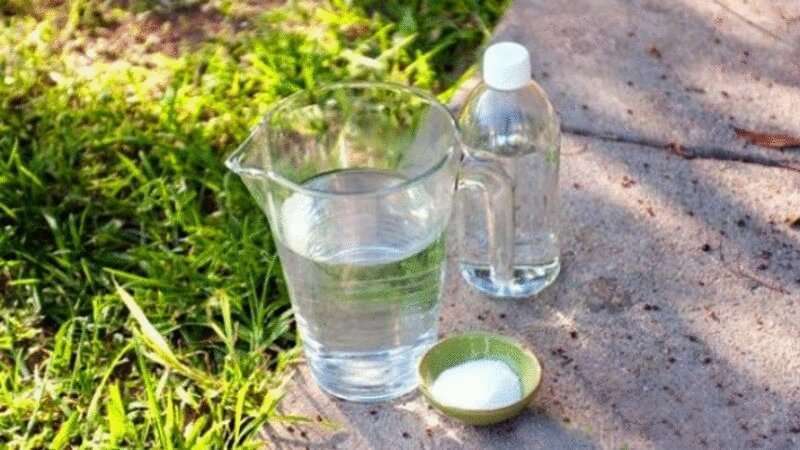
At the initial stage of the disease, you can try folk remedies. Recipes include components that are harmless to health:
- Baking soda and laundry soap. Dissolve an equal amount of soda and grated soap (50 g each) in 10 liters of hot water. Stir, let cool. Process leaves on both sides. The time interval between treatments is 1 week, the frequency of treatments is until the complete disappearance of powdery mildew.
- Whey or kefir. Mix one part of a fermented milk product (optional) with 10 parts of water. Spray three times in a row for three days. After rain, repeat the procedure unscheduled.
- Potassium permanganate. Dissolve 0.5 tsp in 10 liters of water. potassium permanganate. Water the plant three times, repeat the procedure every seven days.
- Ash and laundry soap. Pour 1 kg of ash previously sifted into 10 liters of water. Let it brew for 4-5 days, stirring occasionally. After add 2 tbsp. l. grated laundry soap and strain. Carefully process the leaves on both sides.
You should not rely only on folk methods; with an integrated approach, the effectiveness of treatment can be achieved much faster.
How to process in different seasons
Processing of currant bushes consists of several stages: spring, summer and autumn. Neglecting any of them threatens to lose crops next season. The summer stage requires spraying with chemicals before the berries ripen. If necessary, the treatment is supplemented with biological products.
In autumn, it is important to burn old branches, fallen leaves and shoots. The trunk circle is completely cleaned of leaves and fertilized. Autumn dressings should contain potassium chloride and superphosphate.
For reference. It is better to avoid nitrogen-containing dressings in autumn so as not to provoke active growth of shoots.
In the spring
The spring stage of processing is the largest. One of the surest ways of prevention is to replace the top fertile soil with new humus, for example, vermicompost. Together with the old soil, most of the frozen fungal spores leave.
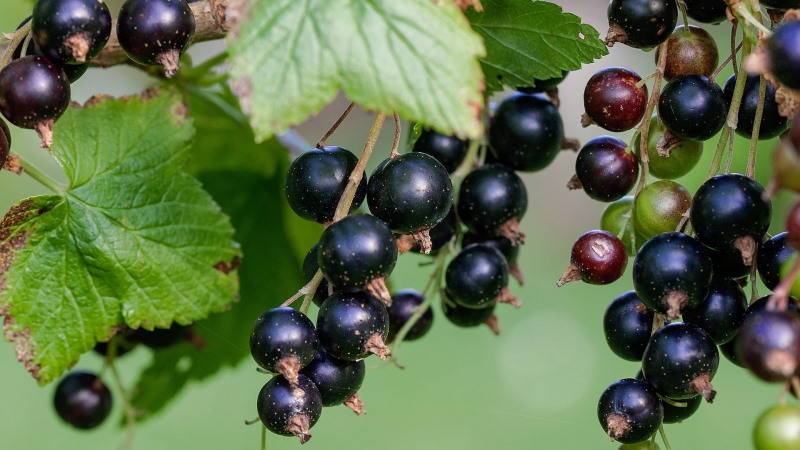
Processing currants in the spring from powdery mildew also includes:
- Irrigation of bushes with boiling water until the snow melts. Carried out in March - early April, depending on the climate - it is important to be in time before bud break. It is more convenient to pour over the bushes with a watering can with a spray. For each bush take 5-6 liters of boiling water. Maintain the distance from the bush to the watering can - 10 cm. The processing time for each plant is no more than 5 seconds. Irrigation with boiling water is carried out only once
- Treatment of the trunk circle with a solution of tansy. Recipe: 80 g of dry raw materials are soaked in 10 liters of water for 24 hours, then brought to a boil, boiled for 20 minutes, the solution is filtered. Before use, dilute with water in a ratio of 1: 5. Plants are sprayed in early spring.
- Spraying with a solution of copper sulfate until the buds swell. To prepare a 0.5-1% solution, 50-100 g of the product are diluted in 10 liters of water. The procedure is carried out at positive temperatures. They cultivate branches and the ground under the bushes.
- Moisture-charging watering. It is applicable for spring moisture deficit after winter with little snow. Water should not fall on the trunk and around it - 12-15 cm recede from the center and water the soil with a hose.
- Spraying the plant before flowering the listed fungicides and biological products at least 3-4 times per season in accordance with the instructions.
The solution should be applied to all parts of the leaves. Typically, spraying occurs before flowering, during flowering and immediately after.
During fruiting
During the ripening period of berries, irrigation with fungicides is stopped due to their toxicity. Biologicals are used as an alternative, but the frequency of treatment is increased. It is also appropriate to use folk remedies.
It is interesting:
How and when to collect currant and raspberry leaves for drying for the winter.
Conclusion
Powdery mildew is a common disease with characteristic symptoms. Depending on the season, measures to combat the spheroteka differ. Folk remedies are used as prevention of disease.
With progression, it is better to start treatment with biofungicides or fungicides, in this case, the likelihood of preserving the crop increases.